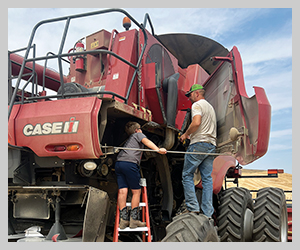
It is hard to remember the last time we had a “normal” year in farming. In fact, you talk with most folks out there, and no one can remember what a normal year even looks like anymore. This year proved that point with 10-year record high wheat prices, scarcity in equipment, input prices skyrocketing, and abnormally wet spring months. Thankfully, even with all the challenges that 2022 brought us, most farmers out there are in the best financial position in quite some time.
While it is hard to pinpoint one specific reason why farmers are so well off this year, factors such as the culmination of built-up carry-over crops, crop insurance payments, Emergency Relief Program payments this spring, and rising wheat prices all played a part in record 2022 profits. Increased profits generally mean taxes, and if you’re like any person I know, no one enjoys paying taxes. On the tax front, not much has changed to the bulk of the tax law since the major overhaul in 2017, but we are nearing closer to the sunset period on those laws, which means we need to be planning how to handle these profits we are experiencing now.
The Tax Jobs and Cuts Act (TJCA) of 2017 revamped many tax laws through Dec. 31, 2025. One of the main tools that get utilized regularly by farmers to minimize taxes is accelerated depreciation. Beginning in 2023, bonus depreciation is the first area to see a significant change. Under the current tax laws, bonus depreciation allows assets with an IRS class life of 20 years or less to be expensed entirely in the year the asset is placed into service. In 2023, we start the phase-out of bonus depreciation, where it drops by 20% each year until it is fully expired by 2027. An essential item to remember that can confuse taxpayers when comparing bonus depreciation to a similar tool in Section 179 is when the asset is placed into service. This timing difference can be critical when you have a fiscal year-end corporation, as bonus depreciation always follows year-end calendar rules for when the asset is placed in service. In contrast, Section 179 follows the tax year for the filed return. Although Section 179 has been an effective tool for many farmers over the years, bonus depreciation allows expensing farm structures such as shops and other real property improvements. While we have little time left in 2022 to complete any projects, being aware of the future phased-out expiration dates can avoid any unexpected surprises during tax planning meetings.
Another change that the TJCA brought us in 2017 was favorable tax rates and a newly created offshoot of the 199A deduction, dubbed the qualified business income (QBI) deduction. The tax rates, which dropped most brackets by a few percentage points, have successfully created sizeable differences in total tax in years of high profits. On the 199A front, the expanded IRS code from the TJCA created a QBI deduction that allowed individuals the ability to calculate a deduction of up to 20% of the qualifying business income. While the formula is quite complex, the deduction has been beneficial in saving tens of thousands of dollars each year since it was implemented. Both the rates and the QBI deduction are set to expire on Dec. 31, 2025.
Increased profits, rising land values and machinery that is now worth more, in some instances, than the original cost have increased net worth amongst individuals. While many farmers laugh when you ask them if their net worth exceeds the 2023 exemption of $12.92 million, in 2026, these estate and gift tax exemptions at the federal level are set to drop to half that amount unless D.C. can come together. This temporary doubling of the exemption brought a unique estate planning opportunity by allowing clients to make large gifts prior to 2026 and secure a much higher exemption. As an added benefit, the IRS released final regulations in 2019 that allowed a decedent to calculate estate tax credits in the year of the gift or the exemption available at death. This will enable individuals to make full use of the current gift exemption without negative tax consequences if the individual’s death occurs after 2025.
Proper planning is critical in today’s climate. While it is nobody’s favorite, we need to be mindful that the tax laws we have in front of us are at all-time historical lows. Utilizing these lower rates to pay taxes now to reduce the carry-over profits, as well as maximizing the exemption laws, can save a person significant amounts rather than waiting for old rates to reappear in 2026.












